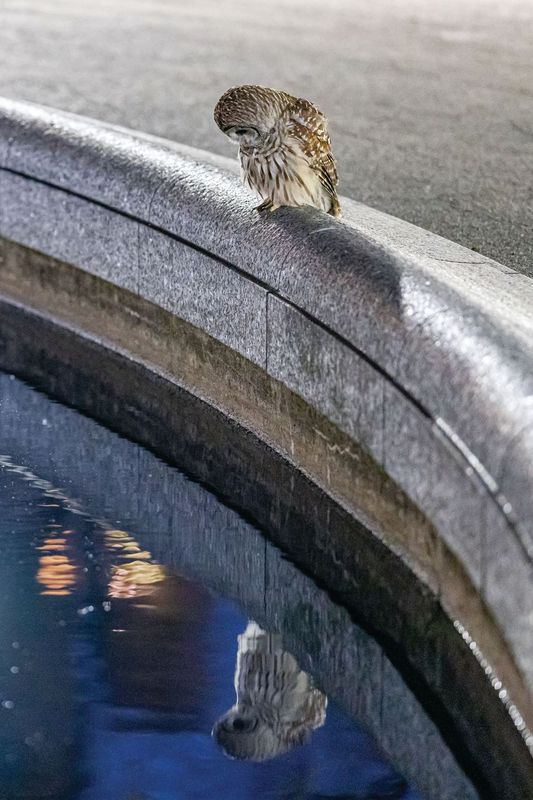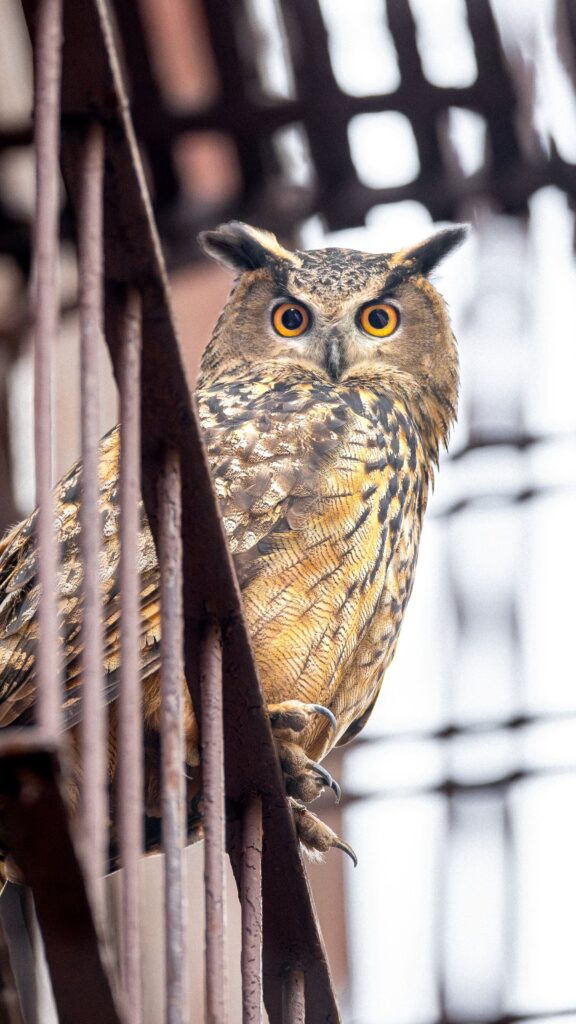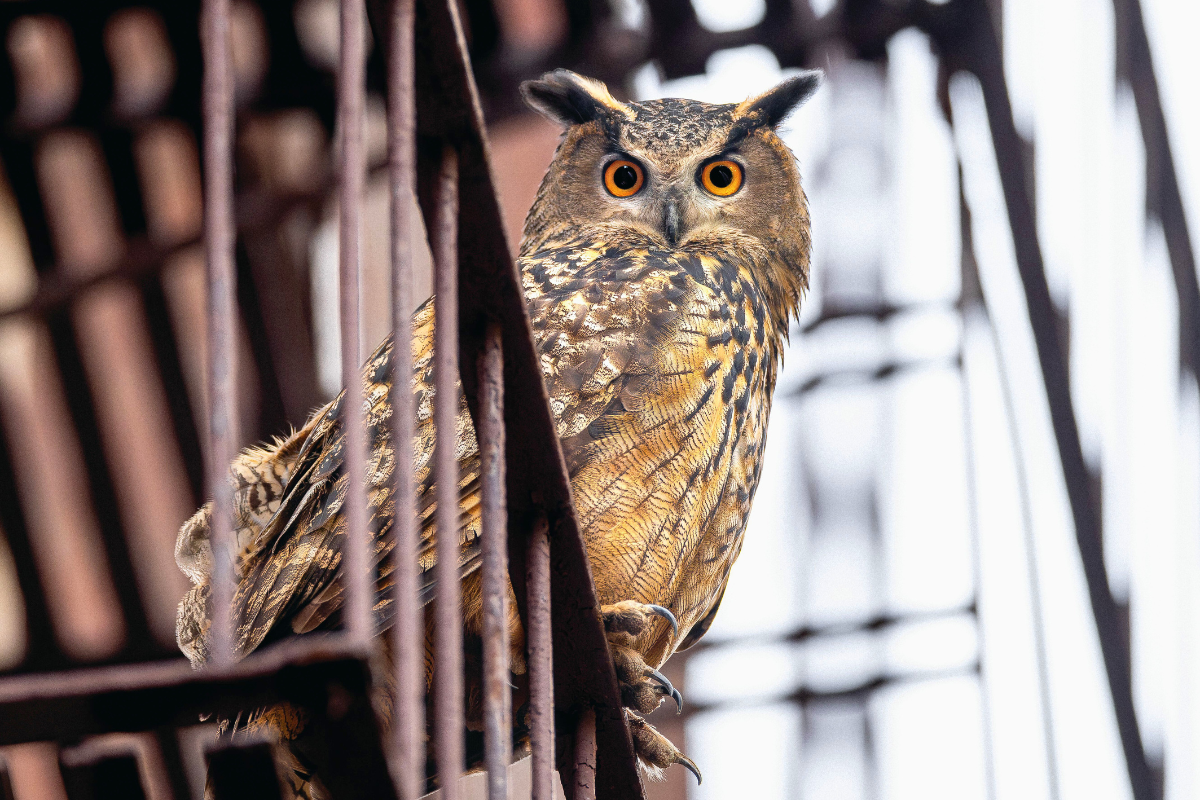By Nicole Rivard and Scott Smith
Flaco the Eurasian eagle owl was suffering from high levels of rat poison and a pigeon-borne illness when he crashed into a New York City building and died, a March 25 necropsy revealed.
Sadly, he is not the first of NYC’s “celebrity owls” to be poisoned by rodenticides. Barry, the beloved barred owl who died in 2021 in Central Park, had a potentially lethal level of rat poison that could have impaired her flying abilities before she crashed into a maintenance truck.

And the list goes on and on.
Hundreds of lesser-known native raptors—red-tailed hawks, Coopers’ hawks, peregrine falcons, owls— have the same thing happen to them that happened to Flaco and Barry, according to Rita McMahon, founder of NYC’s Wild Bird Fund.
No one knows the ability of rodenticides to inflict carnage better than McMahon. In 2023, her nonprofit wildlife rehabilitation center admitted 11,500 patients, most of them birds.
“Rodenticides are devastating our raptors. We are uniquely positioned to see what rodenticides do to them,” McMahon said during a rat contraception webinar hosted in May by the Lights Out Coalition, of which Friends of Animals is a member.
When victims arrive, the signs of anticoagulant rodenticide ingestion are disturbingly clear.
“It’s bleeding excessively from an insignificant wound or bleeding from the mouth or other orifices,” McMahon pointed out. “Or blood pooling beneath the skin on the chest, legs, abdomen or wings, all from internal hemorrhaging. We can administer vitamin K to counteract the effects of the anticoagulant. But typically, by the time these birds are found lying face down in a park, on a roadway or on the sidewalk and brought to the clinic, it’s often just too late.”
These are the innocent victims of NYC Mayor Eric Adams’ ongoing war against NYC’s rats.
“New Yorkers may not know this about me — but I hate rats,” Adams said in a statement to the press last year, just a few months after he hired the Big Apple’s first-ever citywide director of rodent mitigation, Kathleen Corradi.
New Yorker’s refer to Corradi as the “rat czar.”
During the summer of 2023, Adams also announced the new Harlem Rat Mitigation Zone—a $3.5 million investment to accelerate rat reduction work across Harlem. While trash management and containerization have become a priority, anticoagulant rat poison is still a tool in the city’s so-called “toolbox,” and that is bad news for wildlife.
The situation for NYC’s raptors and other wildlife was dire before the rat czar arrived. In 2022, a total of 75,749 pounds of rodenticides were applied by city agencies, according to the NYC Department of Health and Mental Hygiene, up from 62,511 pounds applied in 2021.
This past spring, poisoned birds arrived in rapid succession at Wild Bird Fund, including an adult red-tailed hawk known as BoHo, who was found on her back in Williamsburg; a nesting pair of hawks at Columbia University and another hawk from McClaren Park.
“In memory of Flaco, Boho, the Columbia University hawks,” said McMahon, fighting back tears, “and thousands of others—it’s time to ban rodenticides.”

FoA has pressed members of the New York City Council to introduce a ban on second-generation anticoagulant rodenticides (SGARs) in NYC. At press time we were told that legislation is being drafted.
Rat poison is wildlife poison
FoA helped draft and is advocating for a similar ban in Connecticut for the last few years. The Environmental Protection Agency determined SGARS were so harmful that they pulled them from consumer shelves in 2014. Unfortunately, SGARS are still readily available on the internet to the public, and homeowners can still hire licensed pest control companies to use them.
The pest management professionals will tell you they know how to safely use SGARS — also known as brodifacoum, bromodialone, difenacoum and difethialone. But if the EPA deemed these ingredients so harmful that they can’t be sold in a retailer like Lowes, doesn’t that tell us no matter who uses them, SGARS are extremely unsafe?
Dr. Cynthia Hopf-Dennis, clinical assistant professor at the Janet L. Swanson Wildlife Hospital in Ithaca, N.Y., wishes people would heed the EPA regulations and avoid using anticoagulant rodenticides. “Our wildlife is already facing so many threats — from habitat destruction, to parasites, to disease and car strikes — if we can avoid adding one more human-driven cause to their challenges, we should,” Dennis said.
She was the lead author of a 2022 study by Cornell University College of Veterinary Medicine that revealed 68 percent of red-tailed hawks from New York state tested have anticoagulant rodenticide toxins in their systems.
Rat poisons were detected in 84 percent of dead birds of prey found in New York City, in research conducted by the Wildlife Unit of the New York State Department of Environmental Conservation.
Anticoagulant rodenticide poisons work by preventing blood from clotting. The second-generation class was created to be more toxic and last longer than the first-generation class. Rodents frequently eat more than a single dose. Since the rodent doesn’t die instantly, this allows the rodent to continue consuming the toxins.
Birds of prey don’t have a chance against this super lethal build-up in the rodent’s tissues. So, they’re dying from internal bleeding after consuming poisoned rodents. SGARS not only kill wildlife, but they also weaken and sicken them too, making them vulnerable to other causes of death such as vehicular collisions.
Flaco’s Law moves needle in the right direction
The Adams administration has focused its anti-rat efforts on managing trash —keeping food waste out of black bags and getting black bags off streets and into containers. By October 2024, every New Yorker across all five boroughs will have free, automatic, year-round, weekly collection of compostable material.

Adams has touted his success, a 20 percent decrease in 311 calls about rat activity across the city in July 2023, as compared to 2022. The drop took place from May to mid-July, in the period since the city fully implemented new set-out times and a corresponding collection schedule that minimizes the time trash sits on the curb. Additionally, the city’s four rat mitigation zones (Bronx Grand Concourse, Harlem, Bedford-Stuyvesant/Bushwick, and East Village/Chinatown) saw rat sighting calls decrease by an average of more than 45 percent.
However, we don’t think there is anything to brag about if anticoagulant rodenticides are still being used and killing wildlife.
“If you don’t support banning SGARs then you do support indiscriminate animal cruelty,” said Priscilla Feral, president of Friends of Animals. “These animals arrive at the wildlife rehab centers convulsing and dying after simply eating their prey.”
“Flaco’s Law,” a new bill introduced in April by Council Member Shaun Abreu, would at least eliminate rodenticides in two NYC neighborhoods as part of a rodent birth control pilot program, if it passes. Dr. Loretta Mayer, co-founder of Wisdom GoodWorks, has been working with Abreu and educating him about the non-profit’s fertility control GoodBites, which are plant-based pellets and function as a food supplement for rats and mice, so they are a healthier meal for the city’s wildlife in addition to being an effective population-control measure.
The pellet combines flour, oats, vegetable fat and peanut butter with powder from the root of the “Thunder God” vine. The rodents aren’t sterilized, as infertility only lasts while the pellets are provided and is reversible once the mice or rats stop consuming it.
GoodBites success stories are piling up. The population of rats in the Jamaica Plain neighborhood of Boston, which is the site of a pilot program—has steadily declined, from just over 300 in September 2023 to about 160 in late October 2023. Across the country in Utah, the mouse population in the pigeon enclosure at Best Friends Sanctuary in Utah had dropped by 60 percent in just over six months.
FoA testified in support of Flaco’s Law but went on record saying that “fertility control alone will not stop the carnage of our raptors and wildlife.” We are committed to working tirelessly until NYC and CT get rid of SGARs altogether.
Toxic anticoagulants “mis”-manage rodent problems, which always stem from human behavior— poor sanitation practices and giving rodents access to shelter.
“Harming and killing the animals who naturally regulate rodent populations makes no sense,” Feral said.
“Industry lobbyists will have you believe there will be a public health crisis without SGARs. But there have been no rodent outbreaks in places where they’ve stopped using them—such as California and British Columbia—which is proof that we can protect wildlife without compromising public health.”

